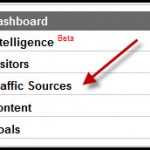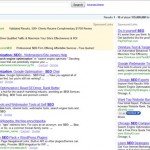One of the most valuable components of an SEO campaign is the correlation of aligning keywords and landing pages.
During the early stages of optimization, it is not uncommon to depend on the authority of the homepage to act as a “catch all” page for your websites most coveted keywords. However, the homepage has been proven as one of the least likely places to facilitate conversion.
Considering that rankings are “by the page” the real objective of search engine optimization is to identify and solidify on page factors to communicate a hierarchical chain of relevance within a website to convey which pages are optimal for the keyword or key phrases in question.
One way to do that is through unifying four vital metrics within the site architecture and on page metrics.
1) Allintitle: a metric that assesses the local and global term weights for keywords in the titles.
2) Allintext: a metric that assess the local and global term weights for keywords in the body text.
3) Allinanchor: a metric that assess the local and global term weights for keywords in anchor text (both from within the site and from other sites to individual pages).
4) Allinurl: a metric that assesses relevance based on mirroring keywords in the URL naming conventions, subfolders or sub domains.
Follow the link ror more information about allintitle, allintext and allinanchor or how to use Google search operators for SEO.
By consolidating these prominent SEO ranking factors through structured search operators and employing SEO by design rather than trying to go back and fix a leaky bucket, it is possible to improve the relevance score for individual keywords systematically as a result of holistic structure, planning and execution.
Consider this your SEO ecosystem which allows each seed (keyword) to become fertile, nourish itself and bear fruit.
In this case, the fruit is to appear in the top 1000 results of Google, make its way to the top 100 and then either use other pages to reinforce topicality and buoyancy and move into the top 10 spotlight.
Step 1: For a landing page to have the proper on page signals to capture a competitive keyword it will require structured dedication and citation such as:
- Enough content on the page (based on the keyword).
- Enough content within the site (to cross the tipping point).
- Enough links from within the site (to establish the internal pages hierarchy)
- Enough links from other sites (if the on page elements are not enough).
Step 2: Planning -Finding the competitive keyword thresholds is not difficult, but assessing your own websites ranking potential is a mandatory step. We call this gap analysis (determining the objective and where you are at present).
In order to navigate the gap, it will require time, content, links and patience; and the more competitive the keyword, the more time, content, trust or links you will need to offset the barrier to entry.
Ideally, the most competitive keywords should be supported by:
- Primary navigation
- A keyword-rich subfolder
- A keyword-rich page naming convention and title
Other metrics for consideration from a standpoint of relevance are:
- Time: how old is the content, is it still relevant?
- Popularity: How many citations are linking to it?
- Supply / Demand: How many times has the page been accessed based on other pages in your website.
- Value: Is the information authoritative, academic or educational or commercial (search engines are programmed with preference).
Step 3: Execution –Map a tiered site structure using theming and siloing to produce the necessary dynamic to propel your pages to the top of the SERPs (search engine result pages).
For your pages:
- Use Exact Match keywords in titles for your primary keyword first, then add secondary or plural search engine proven synonyms (not exceeding three keyword variations).
- Use Relevant Meta Data (Including Information only relevant for that page).
- Use the exact match keyword in the H1 tag, and plural variations in H2 tag if needed.
- Build internal links to that page from other pages that have theme relevance for the keyword (in the title). For example, link similarly themed pages using the anchor text you want the target page to rank for.
- Use the keyword in the first 50 words of the page, and use it at least 2 other times in the document. Preferably you should employ alternate synonyms to reinforce topical relevance (without resorting to spam / keyword stuffed content).
- Acquire inbound deep links to the page from other websites to provide sufficient peer review from search engines (since they measure citation as a favorable metric).
Taking the on page SEO to the next level implies sculpting relevance through the proper utilization of link equity, selecting your preferred landing pages and pairing those pages with a suitable value proposition, call to action and conversion action to facilitate the sales funnel.
Put simply:
- Choose a main category page for each dominant keyword.
- Use subordinate product or article pages to provide structured inbound internal links to support the main category pages.
- Build links to those 3rd or 4th tier pages to provide buoyant ranking factor to the entire keyword cluster (the aggregate semantic collective of related keywords). By building links to the deeper pages in a website, each page in the site above in the hierarchy or the root folder benefit as well.
In the 3rd example above, this alone becomes a priceless component of any SEO strategy. Under the notion that your website is only as strong as its weakest link, as long as each page is nurtured, connected through virtual theming (internal links) or a sitemap or secondary navigation, it can contribute to the global ranking potential for the entire website.
Don’t waste time or opportunity from relying on any one page in your website to do the heavy lifting. Instead, endow each page with vigor and ranking potency by adhering to the solid principles of SEO by design.











Thank you for sharing these tips. They are truly helpful. I agree that one has to build each page on the site. I don’t know if this will help others, but I use market samurai to look for competitive keywords and for keywords that bring the money in.
I was aware of the fact that all pages should have their own target keywords 5 target keywords per page is enough.
I’d be very grateful if you could clarify something related to this… I’m not sure if I’m getting something wrong.
In checking to see how many sites are exact matches in Google (UK) for the keyword (let’s say) “buy overseas property” – I’m entering that string – with the quotes – into the search field and I get 10,300 exact match results.
But if I enter “allintitle:buy overseas property” (without the wrap around quotes), I get 54,100 results.
I would have expected that there would be fewer results for this but clearly of the 18,000,000 broad match pages, I guess some of them would have these words in their page title… which maybe accounts for this.
However, if I also enter this exact string – allintitle:”buy overseas property” i.e. with quotes around the keyword parameter, I get 208,000 matches.
Would you say these are just peculiarities of this particular keyword – although I’ve see similar results on other related keywords or am I missing something?
To establish a start point for either including or excluding a particular keyword phrase from our optimisation efforts, my understanding is that I should enter, for example, “buy overseas property” (i.e. with the quotes around the keyphrase to get the exact match pages and then, “allintitle:buy overseas property” (without the quotes) to find the pages with those words in the title.
If I then find a largish proportion of the exact match pages have the keyphrase in the title, I know the competition is likely to be tough – always assuming there are tens of thousands of exact match pages to start with!
Hopefully I’ve got that right and the results above are just a little ‘strange’.
Any help gratefully received.
Andy:
Keep in mind that allintitle and allintext can have higher quantities of indexed pages.
Based on the example you used, it shows the threshold for the barrier to entry, but you can always go to the bottom of the Google search and keep clicking the last page until you find when the results go supplemental.
You will see the message, Google has omitted certain search results… (which means that less sites with more duplicate content are competing).
The quotes are acturate 10,300 in that index for example, which is not competitive, but you can see my the other metrics which competitors are leaning into what metrics on a keyword by keyword basis.
A free tool that consolidates this is http:www.nichewatch.com